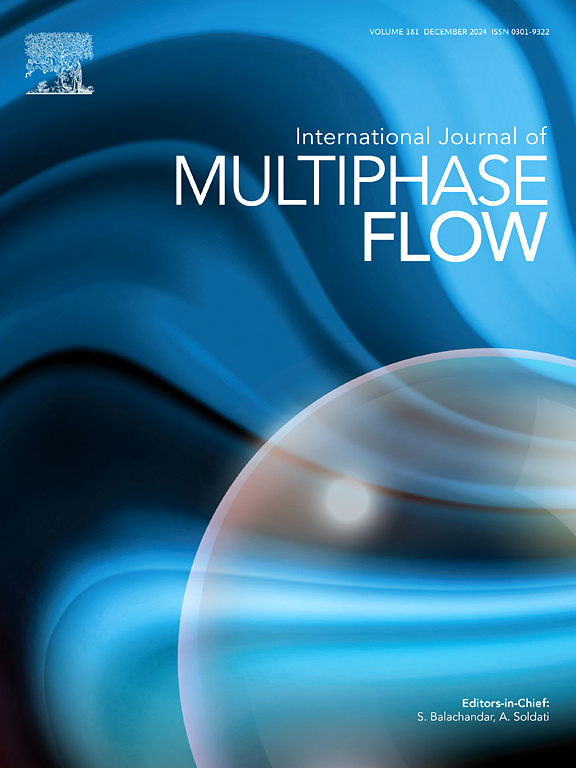Exploring the influence of surface microstructures on cloud cavitation control: A numerical investigation
IF 3.6
2区 工程技术
Q1 MECHANICS
International Journal of Multiphase Flow
Pub Date : 2025-03-07
DOI:10.1016/j.ijmultiphaseflow.2025.105206
引用次数: 0
Abstract
This study explores the influence of surface microstructures, on controlling cloud cavitation dynamics over a three-dimensional Clark Y hydrofoil. The investigation focuses on the effects of rows of semi-spherical microstructures, strategically placed at three different locations on the hydrofoil's suction side. The study utilizes the Large Eddy Simulation (LES) approach to investigate the influence of these configurations on the cloud cavitation lifecycle, focusing on aspects such as cloud shedding frequency, hydrofoil efficiency, cavitation volume, and overall unsteadiness. The Reynolds number is considered to be and the angle of attack of the hydrofoil is fixed at 8 degrees. The results showed that placing the microstructures near the leading edge prolonged the sheet cavity and reduced the cloud cavitation shedding frequency by 5 %. However, this configuration also resulted in an 11.45 % decrease in the lift-to-drag ratio. Positioning semi-spherical microstructures along the mid-chord line resulted in a 4 % increase in cloud cavitation shedding frequency and a 5 % reduction in the lift-to-drag ratio. In contrast, implementing the semi-spherical surface microstructures near the trailing edge influenced the re-entrant jet and local pressure distribution, breaking large cavities into smaller ones. This naturally increased the frequency of cavity shedding by 19.4 % while also increasing the lift-to-drag ratio by approximately 2.5 %. The study also analyzes surface-vortex-cavitation interaction using the vorticity transport equation, finding that microstructures enhance vortex stretching while reducing vortex dilatation and baroclinic torque terms. Overall, the findings suggest that microstructures can stabilize cloud cavitation, leading to a more uniform pressure distribution and smoother flow over the hydrofoil.

探讨表面微观结构对云空化控制的影响:数值研究
本研究探讨了三维Clark Y型水翼表面微观结构对控制云空化动力学的影响。调查的重点是在水翼吸力侧的三个不同位置战略性地放置半球形微结构的影响。该研究利用大涡模拟(LES)方法来研究这些配置对云空化生命周期的影响,重点关注云脱落频率、水翼效率、空化体积和整体不稳定性等方面。考虑雷诺数为7×105and,水翼的攻角固定在8度。结果表明,靠近前缘放置微结构可以延长片状空化的时间,使云空化脱落频率降低5%。然而,这种配置也导致升阻比降低了11.45%。在中弦线上定位半球形微结构,云空化脱落频率增加了4%,升阻比降低了5%。相比之下,在尾缘附近实施半球形表面微结构会影响再入射流和局部压力分布,将大空腔分解成小空腔。这自然使空腔脱落的频率增加了19.4%,同时也使升阻比增加了约2.5%。研究还利用涡度输运方程分析了表面-涡-空化相互作用,发现微观结构增强了涡的拉伸,同时减少了涡膨胀和斜压扭矩项。总的来说,研究结果表明,微观结构可以稳定云空化,从而使水翼上的压力分布更均匀,流动更顺畅。
本文章由计算机程序翻译,如有差异,请以英文原文为准。
求助全文
约1分钟内获得全文
求助全文
来源期刊
CiteScore
7.30
自引率
10.50%
发文量
244
审稿时长
4 months
期刊介绍:
The International Journal of Multiphase Flow publishes analytical, numerical and experimental articles of lasting interest. The scope of the journal includes all aspects of mass, momentum and energy exchange phenomena among different phases such as occur in disperse flows, gas–liquid and liquid–liquid flows, flows in porous media, boiling, granular flows and others.
The journal publishes full papers, brief communications and conference announcements.

 求助内容:
求助内容: 应助结果提醒方式:
应助结果提醒方式:


